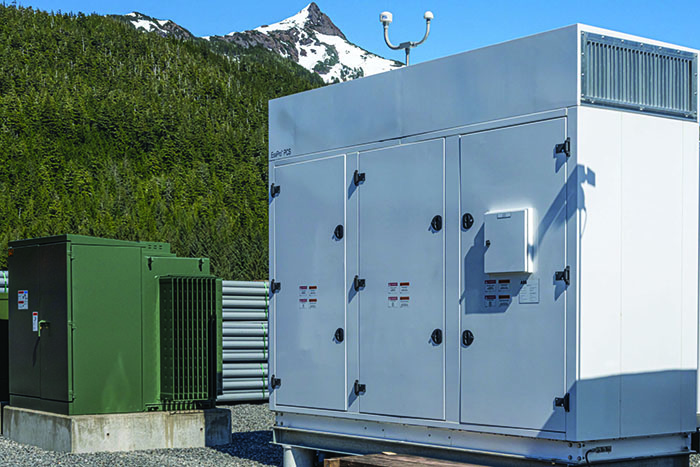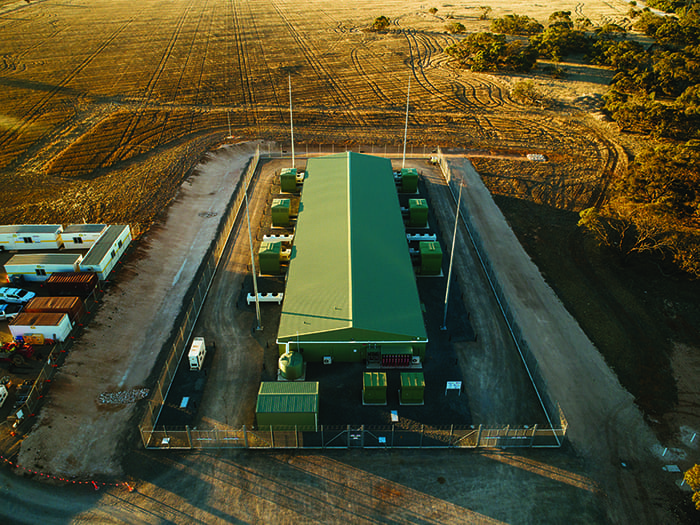Why Microgrids Are the Key to Our Carbon-Neutral Future
As we continue to work toward a more sustainable future globally, demand for renewable energy integration is increasing. This requires more flexibility in grid infrastructure and the ability to add more types of distributed energy resources (DERs), including wind and solar. There is also a strong drive to move beyond a centralized grid to a more distributed one in order to reduce large-scale outages and deliver electricity to remote areas. Declining technology costs for key DER assets such as solar PV and advanced energy storage systems—as well as business models linked to long-term financing offers—are driving accelerated adoption of smaller, smarter, and cleaner energy systems.
The origin story of microgrids goes back more than 30 years to Mawson station in Antarctica. This research operation had a problem. The station relied entirely on diesel and needed a platform system to both generate and stabilize energy output. This was ultimately accomplished by integrating two wind turbines to capture wind energy and convert it into an electric boiler, creating an entirely new concept.
Microgrids, by common definition today, are smaller-scale self-sufficient generation and distribution systems. They allow the energy network to evolve and address new challenges and applications. Every day new use cases are expanding the definition of microgrids, from those used in remote regions with extreme conditions to large utility or commercial systems with both energy reliability and new market-driven needs.
This expanded view of microgrids is driven by many factors, including climate change, energy distribution, the rise of electric vehicles (EVs), and new commercial models. All these examples are converging around the need for more sustainably based electrification. While we continue to integrate high amounts of renewable energy, we’re also now solving for climate-related challenges like wildfires, earthquakes, and severe hurricanes, increasing our need for energy resiliency.
The general availability of microgrids changes the construct of the power system, creating new, more efficient utility operations, including how we consume energy and where it comes from. It enables grid resilience against extreme events, removes infrastructure limitations as an inhibitor to electric power, and brings transmission and distribution to the 21st century.
Why Microgrids Are Needed
International Energy Agency data indicates that 13% of the world (940 million people) does not have access to electricity, and it’s especially limited in remote communities and regions with extreme environmental conditions. The World Bank found that approximately 47 million people rely on microgrids globally. Yet, most of the world’s population without electric power still lacks the resources and economic means to develop large-scale grid infrastructure development projects, making the focus on lower-cost, easier-to-manage microgrid projects a critical alternative.
Communities in remote locations and businesses looking for more secure power supplies represent another growing market of perfect candidates for today’s sophisticated microgrid technologies. Microgrids represent a flexible, easier-to-deploy, and often lower-cost option for businesses and enterprises like hospitals, police stations, and college campuses that benefit from having their own self-sufficient continuous-flowing power supply systems, and reduce the risk from wildfires, storms, and other drivers of unplanned power outages.
With the fast-growing renewable energy segment, microgrids become even more enticing to deploy. Wind and solar photovoltaic (PV) installations are expected to capture the largest share of global power projects over the next 30 years. In order to integrate intermittent resources like wind and solar on the grid, it will take a wide variety of new technologies to balance energy supply, including the integration of energy storage systems.
This rapid growth in distributed energy resources creates even more opportunities for hybrid systems that incorporate new energy storage technologies and sophisticated energy management systems. Today’s hybrid microgrids integrate renewable energy, energy storage technology, and advanced grid-management software.
Types of Microgrids and Success Stories
There are three common types of microgrids: off-grid, grid-connected, and behind-the-meter.
Off-Grid Microgrids. The most common type is the off-grid microgrid, which is often found in remote and island communities that are not connected to a main power grid and often rely largely on expensive diesel fuel for power. These types of microgrids ensure a path toward energy independence and allow these communities to reduce or entirely eliminate reliance on diesel, instead incorporating renewable energy resources and energy storage. Off-grid microgrids can also be used at industrial sites, such as mining operations, to provide power reliability to factories and plants that aren’t on an interconnected grid.
Cordova, Alaska, implemented an advanced microgrid system to reduce dependency on diesel fuel, which had to be imported by ship, and was costly and environmentally hazardous. Cordova Electric Cooperative, the town’s electric company, decided to invest in renewable power, including two new hydroelectric projects that today supply about 78% of the town’s power needs.
 |
|
1. Cordova, Alaska, implemented an advanced microgrid system that includes the battery energy storage system shown here. Courtesy: Hitachi ABB Power Grids |
One of the key components of this off-grid microgrid plan involved installing a state-of-the-art battery energy storage system (BESS), which helps balance the power system when the run-of-river hydro projects are unavailable. The BESS (Figure 1) is used to stabilize grid frequency when hydro-turbines are not generating power. The microgrid system is performing so well that savings on diesel fuel are estimated to be between 40,000 and 50,000 gallons per year. The microgrid also lays a foundation for future needs of the city, such as supporting charging for EVs and boats.
Another example is South Africa’s Robben Island in Cape Town, which developed a microgrid to save up to 75% (600,000 liters) of its diesel fuel usage per year. The combined solar and BESS allows the island to run on solar energy up to nine months of the year. The microgrid can also be managed remotely, which is important when challenging weather conditions prevent easy travel over water to the island.
Grid-Connected Microgrids. Large-scale, grid-connected microgrids are gaining interest in today’s energy market as we look toward increasing renewable energy and decreasing use of fossil fuels globally. In these deployments, the microgrid has a physical connection to a large-scale utility grid but is able to disconnect and reconnect as needed. These types of microgrids allow for greater flexibility and can also increase reliability of the power supply. This means the microgrid can be designed with a combination of renewables and energy storage that allows an operator to disconnect from the main grid and run independently. When capacity runs out, it can reconnect to the network or drop some loads within the microsystem.
 |
|
2. The Energy Storage for Commercial Renewable Integration (ESCRI) project is a grid-connected microgrid designed to help integrate renewable energy into South Australia’s energy mix. Courtesy: Hitachi ABB Power Grids |
A good example of this is the Energy Storage for Commercial Renewable Integration (ESCRI) project, with ElectraNet, a transmission company in Australia, which has installed a BESS to enable the network to operate essentially as a large microgrid. The ESCRI project (Figure 2) is the first transmission grid-connected battery in Australia’s National Electricity Market. Situated on the far end of a radial transmission line in South Australia’s Yorke Peninsula, a region with one of the highest proportions of wind and solar in the world, the grid-connected microgrid integrates this renewable energy mix onto the network. This improved the overall reliability of power supply, delivering enough power to run 400 homes for 24 hours straight, without the input from the renewable generator.
Behind-the-Meter. Behind-the-meter (BTM) microgrid systems run as part of the wider distribution network but operate independently as they don’t need to go through a meter to deliver energy to the end-user. BTM microgrids are quickly emerging as an important option for communities and other large-scale energy systems located within a municipal footprint and are also aiding in the vehicle-to-grid transition.
Odds Soccer Club with Skagerak Energi introduced a first-of-a-kind sophisticated BTM microgrid combining rooftop solar PV, energy storage, and advanced grid automation to energize the Skagerak Arena in Skien, Norway. The entire rooftop of the arena is covered with 5,700 square meters of solar modules. The system not only lights up the arena under low-light conditions, but it also serves the neighborhood’s power needs. The project incorporates a sophisticated energy management system that incorporates optimal load dispatch using load forecasts and PV production while simultaneously taking electricity price developments into consideration.
Digital Technology Is the Backbone of Tomorrow’s Microgrids
No matter the deployment type, assets within microgrids must be coordinated or they won’t be able to run efficiently or reliably. This is why digital technologies are the backbone of microgrids and are expanding in importance. But digital capabilities vary, and the microgrid simply won’t function well without an advanced digital foundation that includes supervisory control and data acquisition (SCADA) technology, control and automation features, energy management systems, and sound cybersecurity protection.
Most of what is done on an automation level has to do with the coordination of different assets on a small scale. And, on the network side, the number of assets is increasing in parallel with more electrification. To maintain these assets and maximize their potential, operators must be able to continuously capture and analyze data on performance, stability, and load to solve problems before failure occurs. If something happens to one asset, all the others will be out of sync as well. Forecasting based on asset data helps to mitigate issues and increase reliability.
Electrification complemented by today’s microgrid technologies has the potential to electrify homes, communities, and countries across the globe. The expansion of electricity as a future energy resource is certain. Along with continued growth in microgrids, other electrification efforts in improved transportation, energy storage, and more efficiently run cities, buildings, and businesses are indicative of the changing landscape of the electric grid, and digital technology will make the orchestration possible.
The DER assets that underpin the shift to microgrids can support a variety of mutually shared value propositions in the new energy landscape through value stacking and enhanced prosumer engagement. Combined with advanced management systems and enabling technologies that can integrate diverse DER portfolios into dynamic, optimized aggregations, assets once considered as the most expensive available are now projected to be the lowest-cost options over time. ■
—Alexander Frick is manager of Services with Hitachi ABB Power Grids.